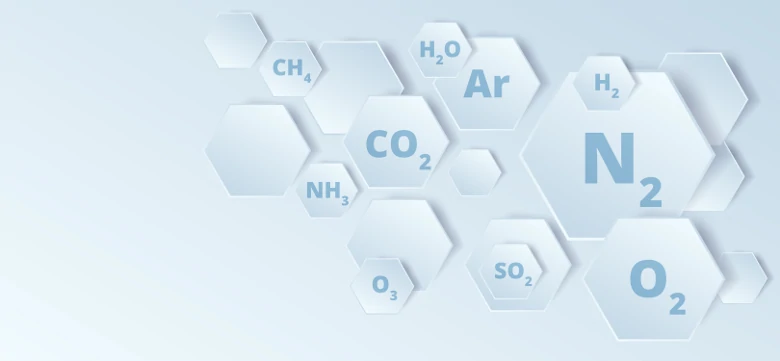Chemical Calculations
In this article, we will be learning how to perform calculations from chemical reactions. These are the learning outcomes:
- Calculate masses of reactants and products by using mole ratio in a chemical equation.
- Calculate volumes of gaseous reactants and products using mole ratio in a chemical equation.
This article is written keeping in mind the requirements of the students studying the Upper Secondary Chemistry syllabus in Singapore.
What is Stoichiometry?
It is the relationship between the number of moles of reactants and the number of moles of products in a chemical reaction.
Consider the following reaction:
\(\small{\begin{align*} \text{magnesium + oxygen} &\quad\xrightarrow[\qquad\qquad]{}\quad \text{magnesium oxide}\\[2ex] \mathrm{2Mg \,(s)+ O_2 \,(g)} &\quad\xrightarrow[\qquad\qquad]{}\quad \mathrm{2MgO\,(s)} \end{align*}}\)
In terms of moles, this equation tells us that two moles of magnesium react with one mole of oxygen gas to form two moles of magnesium oxide.
The coefficients that you see in the balanced chemical equation tells us the ratio of the number of moles of reactants and products that are involved in this chemical reaction.
Mole ratio of magnesium to oxygen to magnesium oxide is \(\small{2 : 1 : 2}\)
However, this ratio cannot be applied to mass.
It is incorrect to say that \(\small{\text{48 g}}\) of magnesium reacts with \(\small{\text{24 g}}\) of oxygen gas to form \(\small{\text{48 g}}\) of magnesium oxide. This does not obey the law of conservation of mass, where it states that matter can neither be created nor destroyed in a chemical reaction. The total mass of the reactants must be equal to the total mass of the products.
So let us see how we can determine the mass of the reactant consumed or the product formed in a reaction using stoichiometry.
Calculating Masses of Reactants and Products
Example 1:
When \(\small{\text{8.4 g}}\) of magnesium carbonate is heated, it decomposes into magnesium oxide and carbon dioxide. Calculate the mass of magnesium oxide formed.
Solution:
Whenever you come across a chemical calculation question, all you need to do is to follow four simple steps.
-
Step 1: Construct the balanced chemical equation (if not provided).
\(\small{\mathrm{MgCO_3} \quad\xrightarrow[\qquad\qquad]{}\quad \mathrm{MgO+ CO_2}}\)
-
Step 2: Convert the given quantity into moles.
\(\small{\begin{align} \text{Number of moles} &= \frac {\text{Mass (in g)} }{\text{Molar Mass (g/mol)}}\\[2ex] \text{So, number of moles of }\mathrm{MgCO_3} &= \frac {8.4}{24 + 12 + 3 \times16 }\\[2ex] &= 0.1 \text{ mole} \end{align}}\)
-
Step 3: Use the mole ratio from the equation to deduce the number of moles of the other substance.
\(\small{\begin{align} \mathrm{MgCO_3} \quad\xrightarrow[\qquad\qquad]{}\quad \mathrm{MgO+ CO_2} \end{align}}\)
\(\small{\bbox[5px,border:2px solid #262262] {\begin{align} \mathrm{MgCO_3} &: \mathrm{MgO}\\[2ex] 1 &: 1\\[2ex] 0.1 &: 0.1 \end{align}}}\)
-
Step 4: Convert mole to the required unit.
\(\small{\begin{align} \text{Mass} &= \text{Number of moles × Molar mass}\\[2ex] \text{Mass of MgO} &= \mathrm{0.1 \times (24 + 16)}\\[2ex] &= \text{4 g} \end{align}}\)
Test Your Skill
Question 1:
Magnesium reacts with oxygen as shown below.
\(\small{\mathrm{2Mg+ O_2} \quad\xrightarrow[\qquad\qquad]{}\quad \mathrm{2MgO}}\)
\(\small{(A_r \text{ of Mg = 24, O = 16 )}}\)
What is the mass of oxygen required to completely react with \(\small{\text{12 g}}\) of magnesium?
- \(\small{\text{4 g}}\)
- \(\small{\text{8 g}}\)
- \(\small{\text{16 g}}\)
- \(\small{\text{32 g}}\)
Solution:
(B) \(\small{\text{8 g}}\)
Explanation:
\(\begin{align} \text{Number of moles of Mg} &= \frac {12}{24}\\[2ex] &= 0.5 \text{ mole} \end{align}\)
\(\bbox[5px,border:2px solid #262262] {\begin{align} \mathrm{Mg} &: \mathrm{O_2}\\[2ex] 2 &: 1\\[2ex] 0.5 &: 0.25 \end{align} }\)
\(\begin{align} \text{Mass of }\mathrm{O_2} &= 0.25 \times (16 \times 2)\\[2ex] &= \text{8 g} \end{align}\)
Question 2:
When potassium hydrogen carbonate \(\mathrm{(KHCO_3)}\) is strongly heated, the following reaction occurs.
\(\mathrm{2KHCO_3 \,(s)} \quad\xrightarrow[\qquad\qquad]{}\quad \mathrm{K_2CO_3 \,(s) + H_2O \,(g) + CO_2 \,(g)}\)
\((A_r \text{ of K = 39, O = 16, C = 12, H = 1)}\)
What is the mass of potassium carbonate formed when \(\text{40 g}\) of potassium hydrogen carbonate is heated?
- \(\text{7.2 g}\)
- \(\text{14.4 g}\)
- \(\text{27.6 g}\)
- \(\text{55.2 g}\)
Solution:
(C) \(\text{27.6 g}\)
Explanation:
Number of moles of KHCO3 = \(\frac {40}{39\; + \;1 + \;12 \; + \;3 \;\times\;16 }\)
= 0.4 mole
KHCO3 : K2CO3
2 : 1
0.4 : 0.2
Mass of K2CO3 = 0.2 × (2 × 39 + 12 + 3 × 16)
= 27.6g
Calculating volumes of Reactants or Products
Example 2:
Iron(III) oxide reacts with carbon monoxide to give iron and carbon dioxide. Determine the volume of CO2 released when 5.0 g of Fe2O3 reacts completely in the reaction.
Solution:
- Step 1: Construct the balanced chemical equation.
Fe2O3 + 3CO ———► 2Fe + 3CO2
- Step 2: Convert the given quantity into moles.
Number of moles of Fe2O3 = \(\frac {5.0}{2\; \times \;56\; + \;3 \;\times\;16 }\)
= 0.03125 mol
- Step 3: Use the mole ratio from the equation to deduce the number of moles of the other substance.
Fe2O3 + 3CO ———► 2Fe + 3CO2
Fe2O3 : CO2
1 : 3
0.03125 : 0.09375
- Step 4: Convert mole to the required unit.
Volume of CO2 = 0.09375 × 24
= 2.25 dm3
Question 3:
Magnesium reacts with hydrochloric acid as shown below.
Mg (s)+ 2HCl (aq) ———► MgCl2 (aq) + H2 (g)
(Ar of Mg = 24, Cl = 35.5, H = 1)
What volume of hydrogen gas at r.t.p is produced when an excess of the acid is added to 6 g of magnesium?
- 1 dm3
- 6 dm3
- 12 dm3
- 24 dm3
Solution:
(B) 6 dm3
Explanation:
Number of moles of Mg = \(\frac {6}{24}\)
= 0.25 mole
Mg : H2
1 : 1
0.25 : 0.25
Volume of H2 = 0.25 × 24 dm3
= 6 dm3
Question 4:
The reaction between zinc sulfide and oxygen is as follows:
2ZnS + 3O2 ———► 2ZnO + 2SO2
(Ar of Zn = 65, S = 32, O =16)
What is the volume of sulfur dioxide at r.t.p that will be produced when 9.7 g of zinc sulfide is heated in air?
- 3.6 dm3
- 2.4 dm3
- 1.2 dm3
- 4.8 dm3
Solution:
(B) 2.4 dm3
Explanation:
Number of moles of ZnS = \(\frac {9.7}{65\;+\;32}\)
= 0.1 mole
ZnS : SO2
2 : 2
0.1 : 0.1
Volume of SO2 = 0.1 × 24
= 2.4 dm3
Mole Ratio = Volume Ratio
Recall that one mole of any gas at room temperature and pressure occupies 24 dm3.
This means that the volume of gas is proportional to the number of moles of gas.
For chemical calculations involving gaseous reactants and products, the mole ratio of the gasses in a balanced chemical equation is the same as the volume ratio of the gasses.
For Gaseous Substances Comparison only
Consider the following reaction involving gasses.
hydrogen + chlorine ———► hydrogen chloride
H2 (g) + Cl2 (g) ———► 2HCl (g)
In terms of mole, 1 mole of hydrogen gas reacts with 1 mole of chlorine gas to form 2 moles of hydrogen chloride gas.
In terms of volume, 1 volume of hydrogen gas reacts with 1 volume of chlorine gas to form 2 volumes of hydrogen chloride gas.
Example 3:
Consider the following reaction involving gasses.
H2 (g) + Cl2 (g) ———► 2HCl (g)
Calculate the volume of hydrogen chloride produced when 50 cm3 hydrogen gas is reacted completely at r.t.p.
Solution:
Find the volume ratio of HCl to H2 from the equation.
\(\frac {\;\; Volume \; of \;HCl \;\;} {\;\; Volume \;of \;H_2 \;\;}\) = \(\frac { 2 } { 1 }\)
Volume of HCl = 2 × Volume of H2
= 2 × 50 cm3
= 100 cm3
Question 5:
Hydrogen sulfide reacts with oxygen as shown in the following equation.
2H2S (g) + 3O2 (g) ———► 2H2O (g) + 2SO2 (g)
(Ar of S = 32, O = 16, H = 1)
If 50 cm3 of hydrogen sulfide is allowed to react completely in an excess of oxygen, what volume of steam would be produced?
- 20 cm3
- 30 cm3
- 40 cm3
- 50 cm3
Solution:
(D) 50 cm3
Explanation:
\(\frac {\;\; Volume \; of \;H_2S \;\;} {\;\; Volume \;of \;H_2O \;\;}\) = \(\frac { 2 } { 2 }\)
= \(\frac { 1 } { 1 }\)
Volume of H2O = Volume of H2S
= 50 cm3
Question 6:
Methane reacts with steam to form hydrogen and carbon monoxide as shown below.
CH4 (g) + H2O (g) ———► CO (g) + 3H2 (g)
(Ar of C = 12, O = 16, H=1)
What volume of hydrogen can be obtained from 30 cm3 of methane at r.t.p?
- 30 cm3
- 60 cm3
- 90 cm3
- 120 cm3
Solution:
(C) 90 cm3
Explanation:
\(\frac {\;\; Volume \; of \;H_2 \;\;} {\;\; Volume \;of \;CH_4 \;\;}\) = \(\frac { 3 } { 1 }\)
= 3
Volume of H2 = 3 × Volume of CH4
= 3 × 30 cm3
= 90 cm3
Conclusion
In this article, we have learnt about stoichiometry and how we can use it in a balanced chemical equation to calculate the masses of reactants and products as well as the volume of gaseous reactants and products.
All these topics have been discussed keeping in mind the Upper Secondary Chemistry syllabus in Singapore.
Keep Learning! Keep Improving!


 SG
SG  VN
VN 


















